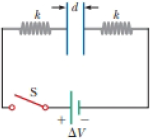
Concept explainers
You are part of a team working in a machine parts mechanic’s shop. An important customer has asked your company to provide springs with a very precise force constant k. You dense the electrical circuit shown in Figure P25.45 to measure the spring constant of each of the springs to be provided to the customer. The circuit consists of two identical, parallel metal plates free to move, other than being connected to identical metal springs, a switch, and a battery with terminal voltage ΔV. With the switch open, the plates are uncharged, are separated by a distance d, and have a capacitance C. When the switch is closed, the plates become charged and attract each other. The distance between the plates changes by a factor f, after which the plates are in equilibrium between the spring forces and the attractive electric force between the plates. To keep the plates from going into oscillations, you hold each plate with insulating gloves as the switch is closed and apply a force on the plates that allows them to move together at a slow constant speed until they are at the equilibrium separation, at which point you can release the plates. You determine an expression for the spring constant in terms of C, d, ΔV, and f.
Figure P25.45 Problems 45 and 50.

Want to see the full answer?
Check out a sample textbook solution
Chapter 25 Solutions
PHYSICS:F/SCI.+ENGRS.,V.1
- A hydrogen atom has just a single electron orbiting the nucleus, which happens to be a single proton without any neutrons. The proton is positively charged, the electron negatively, but both with the same magnitude of charge given by e=1.602x10-19C. The mass of an electron is 9.11x10-31kg, and the proton is 1.67x10-27kg. Find the ratio of the electrostatic to the gravitational force of attraction between the electron and the proton in hydrogen. \arrow_forwardWhat is the third law pair to the normal force as you sit in a chair? What effect does the sun's pull on earth have in terms of third law pairs?arrow_forwardUsing Newton's 2nd law, show that all objects subject to the pull of gravity alone should fall at the same rate. What is that rate?arrow_forward
- No chatgpt pls will upvotearrow_forwardA cart on wheels (assume frictionless) with a mass of 20 kg is pulled rightward with a 50N force. What is its acceleration?arrow_forwardLight travels through a vacuum at a speed of 2.998 x 108m/s. Determine the speed of light in the following media: crown glass (n = 1.52)arrow_forward
- 2.62 Collision. The engineer of a passenger train traveling at 25.0 m/s sights a freight train whose caboose is 200 m ahead on the same track (Fig. P2.62). The freight train is traveling at 15.0 m/s in the same direction as the passenger train. The engineer of the passenger train immediately applies the brakes, causing a constant acceleration of 0.100 m/s² in a direction opposite to the train's velocity, while the freight train continues with constant speed. Take x = 0 at the location of the front of the passenger train when the engineer applies the brakes. (a) Will the cows nearby witness a collision? (b) If so, where will it take place? (c) On a single graph, sketch the positions of the front of the pas- senger train and the back of the freight train.arrow_forwardCan I get help with how to calculate total displacement? The answer is 78.3x-4.8yarrow_forward2.70 Egg Drop. You are on the Figure P2.70 roof of the physics building, 46.0 m above the ground (Fig. P2.70). Your physics professor, who is 1.80 m tall, is walking alongside the building at a constant speed of 1.20 m/s. If you wish to drop an egg on your profes- sor's head, where should the profes- sor be when you release the egg? Assume that the egg is in free fall. 2.71 CALC The acceleration of a particle is given by ax(t) = -2.00 m/s² +(3.00 m/s³)t. (a) Find the initial velocity Vox such that v = 1.20 m/s 1.80 m 46.0 marrow_forward
 Physics for Scientists and Engineers: Foundations...PhysicsISBN:9781133939146Author:Katz, Debora M.Publisher:Cengage Learning
Physics for Scientists and Engineers: Foundations...PhysicsISBN:9781133939146Author:Katz, Debora M.Publisher:Cengage Learning Physics for Scientists and Engineers, Technology ...PhysicsISBN:9781305116399Author:Raymond A. Serway, John W. JewettPublisher:Cengage Learning
Physics for Scientists and Engineers, Technology ...PhysicsISBN:9781305116399Author:Raymond A. Serway, John W. JewettPublisher:Cengage Learning Principles of Physics: A Calculus-Based TextPhysicsISBN:9781133104261Author:Raymond A. Serway, John W. JewettPublisher:Cengage Learning
Principles of Physics: A Calculus-Based TextPhysicsISBN:9781133104261Author:Raymond A. Serway, John W. JewettPublisher:Cengage Learning
 College PhysicsPhysicsISBN:9781285737027Author:Raymond A. Serway, Chris VuillePublisher:Cengage Learning
College PhysicsPhysicsISBN:9781285737027Author:Raymond A. Serway, Chris VuillePublisher:Cengage Learning College PhysicsPhysicsISBN:9781305952300Author:Raymond A. Serway, Chris VuillePublisher:Cengage Learning
College PhysicsPhysicsISBN:9781305952300Author:Raymond A. Serway, Chris VuillePublisher:Cengage Learning





